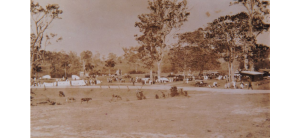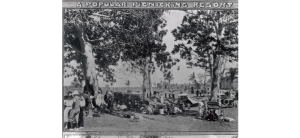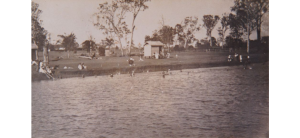Sweeney Reserve
Sweeney Reserve
Lieutenant John Oxley, the Surveyor-General of New South Wales, discovered the Pine River on 1st December 1823 with the assistance of the castaway ticket-of-leave convicts, John Finnegan and Thomas Pamphlett. During his brief ascent of the North Pine River, which took his party as far as the lower section of today’s Sweeney Reserve, Oxley observed a large number of Aboriginal people and commented on the presence of a wall of green bushes used as a weir to trap mullet and whiting in an inlet near the present North Coast Railway Bridge. Oxley also noted the existence of “a great many very fine cypresses” which he later correctly referred to as pines; in his official report, submitted on 10th January 1824, he enthused about the “great quantities of pine” to be seen along the river.
Although the date of Oxley’s discovery can be regarded as marking the commencement of sustained European intervention in the Pine Rivers District, the area had been occupied by the North Pine Clan of the Turrbal people for countless thousands of years. During the mid-19th century, Dalaipi was a distinguished Turrbal elder and rainmaker. It was Dalaipi, then nearly sixty years of age, who encouraged the area’s best-known pioneer, Tom Petrie (1831-1910), to establish a cattle-run in the area. Dalaipi was the Traditional Custodian of a complex of several highly significant cultural sites: the Petrie bora ground known as ‘Nindur-ngineddo’ (literally ‘leech-sitting down’ and so associated with a leech dreaming place), the main ring of which was located near the present Petrie roundabout; the ‘Mandin’ (or Mundin) fishing hole first reported by Oxley’s party, and a rain increase site on the north bank of the North Pine River a short distance upstream from the fishing site. Yebri Creek nearby was also a popular camping area. It has been suggested that, by sharing his land with a person he could trust, Dalaipi was, in fact, protecting his most valuable possession from unsympathetic landholders.
The North Pine River Reserve, which later came to be known as Sweeney Reserve, is the oldest tract of land in the Pine Rivers District preserved for government purposes, having been set aside by the surveyor, James Warner (1814-1891), as a road and water reserve. Warner was sent in 1862 to survey the first batch of 64 country farm allotments in the Redcliffe Agricultural Reserve. By this time, a ford over the North Pine River had been established by Tom Petrie. Following his establishment of the Murrumba Run in 1859, it is likely that the ford, later known as Petrie’s Crossing, and a track roughly following the course of today’s Gympie Road through Lawnton and Strathpine, would have provided Petrie with the means of communicating with other farming families who had settled in the Bald Hills area from 1857. As timber-getters were active in the region from the 1840s seeking valuable softwoods such as Red Cedar, Beech and Hoop Pine, it is likely that a well-developed network of tracks traversed the area prior to Petrie’s arrival. Sweeney Reserve marks the height of navigation on the North Pine River, and it is known that one of the most significant rafting grounds in the Pine Rivers District had been located in this area.
By the first two decades of the 20th century, the reserve was described as “a water reserve and camping ground” and it was extensively used both as a picnic ground and as a resting and watering place for travelling stock. By 1924, the year in which control of the reserve was transferred to the Pine Shire Council, it was reported that the area was so well used “by the public of the city and surrounding districts as a picnic spot” that over 1100 people were present each Sunday during the Christmas holidays. In addition to arriving in motor vehicles, large numbers of visitors caught the train to Petrie Railway Station.
In recognition of its rich history, Sweeney Reserve, which remains as one of the most attractive recreational areas in the Pine Rivers District, was entered in the Queensland Heritage Register on 11th December 2008.
North Pine River Reserve, 1920s.
Courtesy of Eric Willmer.
Moreton Bay Region Libraries (Strathpine Library) P1428/18.
North Pine River Reserve, 1923.
Moreton Bay Region Libraries (Strathpine Library) P0775.
North Pine River Reserve, 1930s.
Courtesy of Eric Willmer.
Moreton Bay Region Libraries (Strathpine Library) P1428/16.



